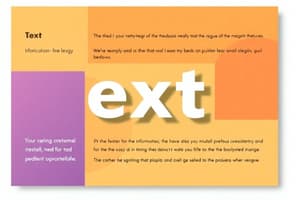Podcast
Questions and Answers
What is the purpose of identifying text structures in a written passage?
What is the purpose of identifying text structures in a written passage?
- To organize and convey information efficiently (correct)
- To prevent readers from retaining information
- To confuse the reader with complex arrangements of ideas
- To limit comprehension by making the text harder to follow
In the sentence 'John bought a ____________.', what does the verb 'bought' suggest about the missing word?
In the sentence 'John bought a ____________.', what does the verb 'bought' suggest about the missing word?
- It must be an action
- It must be a color
- It must be something that can be purchased (correct)
- It must be a food item
Which of the following are examples of text structures?
Which of the following are examples of text structures?
- **Problem and solution** and **Cause and effect** (correct)
- Wikipedia articles and blog posts
- Poetry and fiction novels
- **Sequence** and **Compare and contrast**
What do homographs refer to?
What do homographs refer to?
'Dog' is an example of which of the following?
'Dog' is an example of which of the following?
What do headings do in a text?
What do headings do in a text?
How do subheadings contribute to text comprehension?
How do subheadings contribute to text comprehension?
What do graphs and charts mainly help with in a text?
What do graphs and charts mainly help with in a text?
Which text feature emphasizes key terms and concepts?
Which text feature emphasizes key terms and concepts?
How can readers infer meaning from an unfamiliar word or term?
How can readers infer meaning from an unfamiliar word or term?
Flashcards are hidden until you start studying
Study Notes
Text features and context clues play a crucial role in understanding written content effectively. This article focuses on the subtopics of types of text features, using context clues to infer meaning, identifying text structures, and analyzing homographs, nouns, and related terms.
Types of Text Features
Text features are elements within a text that enhance understanding by providing additional information. These features include:
- Headings: Organize the text into sections, making it easier to navigate and understand.
- Subheadings: Further break down each section, allowing for clearer organization and comprehension.
- Photos and illustrations: Support comprehension through visual cues and reinforcement of concepts.
- Bold words: Emphasize key terms and concepts, helping readers quickly locate essential information.
- Pronunciation guides: Provide assistance in pronouncing difficult words, improving the reading experience.
- Graphs and charts: Visual representations of data and statistics, facilitating interpretation of complex information.
- Maps: Geographical depictions that clarify spatial relationships between different locations or phenomena.
By recognizing and utilizing these text features effectively, readers can better understand and engage with the text.
Using Context Clues to Infer Meaning
When encountering an unfamiliar word or term, one effective strategy is to use context clues to deduce its meaning. Context clues can come from the surrounding words, phrases, or even the structure of the sentence itself.
For example, consider the following sentence:
John bought a ____________.
Based on the context of the sentence, we might deduce that the missing word could be 'book'.
Note here, the verb 'bought', implies something was purchased. So, any word in that position must fit in the realm of things that can be purchased. While 'book' is a standard choice, others could also work depending on the broader context.
This technique allows readers to expand their vocabulary and improve comprehension by drawing connections between known words and their unfamiliar counterparts based on surrounding information.
Identifying Text Structures
Text structures, the patterns and arrangements of ideas within a text, help organize and convey information efficiently. Some common text structures include:
- Sequence: Arrangement of events or steps in order of occurrence.
- Cause and effect: Describing the relationship between an action and its consequence.
- Compare and contrast: Presenting two or more items side by side, highlighting similarities and differences.
- Problem and solution: Introducing a problem, describing its effects, and offering potential solutions.
Understanding these structures helps readers follow along easily when reading, facilitates retention of information, and fosters deeper comprehension.
Homographs, Nouns, and Related Terms
Homographs are words that share the same spelling and pronunciation but have distinct meanings. For instance, the word 'bank' can refer either to a financial institution or the side of a river. In both instances, the word 'bank' sounds identical, but its context determines its specific meaning.
Nouns are words that denote people, places, things, or abstract concepts. They can serve as subjects or objects in a sentence. For example, 'dog' is a noun phrase referring to a particular breed of animal.
Related terms are words that have some semantic connection to one another. They can include synonyms, antonyms, hyponyms, and meronyms. Synonyms are words with similar meanings; antonyms have opposite meanings; hyponyms describe subsets within larger sets; and meronyms represent parts of a whole.
Studying That Suits You
Use AI to generate personalized quizzes and flashcards to suit your learning preferences.




